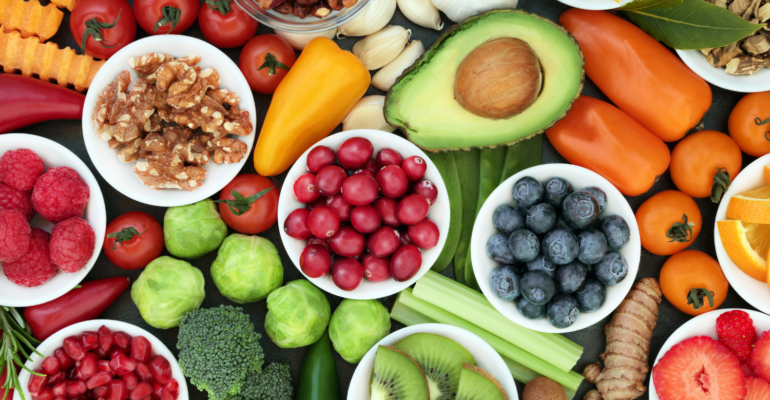Is eating 5 a day really enough?
|
Getting your Trinity Audio player ready...
|
When it comes to fruit and vegetables, the most common advice is to eat ‘5 portions a day’ – but is this guideline amount really enough? Many still assume that eating 5 a day will be sufficient to boost general health and decrease the chance of developing chronic diseases like cancer – but new evidence is emerging that shows consuming an even higher intake of fruits and vegetables might actually be what’s required to ensure optimal health.
What is ‘5 a day’?
Eating 5 portions a day has been promoted for years as a beneficial, healthy move and this advice has been recommended by governments and health organisations around the world. One portion typically equates to approximately one handful, or 80g of fruits or vegetables, though the particular amount can vary from country to country.
There’s little doubt that the aims of this drive are admirable – to encourage people to up their fruit and vegetable consumption and incorporate a diverse range of fruits and vegetables. Diversity is important, so the body can obtain the essential minerals, vitamins antioxidants and fibre it needs to stay healthy.
Yet as nutrition evolves, it’s becoming clear that 5 a day may not be enough to stay in peak health. The World Health Organisation have now updated their advice to recommend a daily fruit and vegetable intake of 400 grams minimum, around 6 portions, and several other countries and institutions are now following suit as the benefits of a higher intake come to light.
The benefits of 5 a day
Though there’s evidence to demonstrate that’s it’s better to aim for more than 5 portions of fruit or vegetables daily, 5 a day is still a good starting point. If you manage it, you’ll obtain several health benefits:
1. You’ll fuel your body with nutrients – Fruits and vegetables contain lots of vitamins and minerals – all of which are fuel for the body, to maintain good health and support essential functions.
2. You’ll lower your risk of disease – Research has demonstrated that consuming a diet high in fruits and vegetables is linked to a lowered risk of chronic diseases, including heart disease, particular cancers and stroke, as well as obesity.
3. You’ll up your fibre intake – Fruits and vegetables are superb sources of dietary fibre, which is crucial for good digestive health, balanced blood sugar and weight management.
4. You’ll boost your antioxidant levels – Antioxidants help to protect against and mop up cell damage by free radicals – and fruits and vegetables have plenty of antioxidants. Eat at least 5 a day and you’ll reduce the risk of chronic diseases and help support your wellbeing, though eating even more will boost your heath further.
Should we eat more than 5 a day?
The ‘5 a day’ guideline is definitely a valuable starting point, though recent studies suggest that consuming more may provide further health benefits.
4 reasons you should up your intake and eat more than 5 a day:
1. To boost nutrient density – Though five portions of fruit and vegetables will give you a good range of health enhancing nutrients and vitamins, if you expand this amount, you’ll increase the benefits even further. Eating more than 5 a day allows you to vary the quantity and diversity of the different fruits and vegetables you consume, providing your body with even more beneficial vitamins, minerals, and phytochemicals.
2. For optimal disease prevention – Research shows that consuming a higher amount of fruits and vegetables is positively correlated with increased protection against chronic disease. There are several studies that demonstrate that a higher intake, equivalent to seven to ten servings, wields a more significant impact on lowering disease risk.
3. To keep up with changing dietary guidelines – As our knowledge of nutrition develops, countries and health organisations are updating their dietary recommendations accordingly. Many have now adjusted their advice to tell people to increase their intake beyond 5 a day, including the WHO.
4. To cater to your unique lifestyle – When considering the amount of fruit and vegetables to consume, it’s important to take into account individual lifestyle factors, like age, sex, and activity level – as well as underlying health conditions. Your personal bodily requirements will play a big part in your dietary requirements, as many people will need to eat more than 5 a day to address their nutrition needs.
How to increase your fruit and vegetable intake
While ‘5 a day’ serves as a valuable guideline, aiming for a higher fruit and vegetable intake can many more health benefits. If you’re finding it a challenge to increase your daily intake, you might find that implementing some practical tips will help you increase your consumption.
1. Vary your intake – Diversity is key when it comes to fruit and vegetable consumption. Use the phrase “eat the rainbow” as a guideline and aim to eat a wide range of fruits and vegetables of different colours and types to ensure you maximize the range of nutrients and antioxidants you’re taking in.
2. Make it easier to meet daily targets – If you find it hard to eat more than 5 a day, keeping pre-prepared cut-up fruits and vegetables on hand so you can indulge in quick, nutritious snacks throughout the day can help you up your intake.
3. Aim to fill half of your plate at each meal – To increase your intake effortlessly, try to ensure that half your plate is filled with a diverse assortment of fruits and vegetables at every meal.
4. Enjoy homemade smoothies and juices – If you don’t already, it might be a good idea to purchase a blender, so you can easily incorporate several fruits and vegetables into tasty smoothies or homemade juices. Though this shouldn’t form the sole basis of your intake, as it’s better to consume many fruits and vegetables raw, it can be a convenient way to increase it.
5. Try your hand at creative cookery – Get creative and enjoy experimenting with different recipes and culinary methods. There are many delicious vegan and vegetarian recipes that can be easily prepared cooked, which can help to make fruits and vegetables more palatable and tempting.
6. Incorporate more fruits and veggies into salads and soups – By adding in extra servings of fruits and vegetables to your soups, salads, stir-fries, or pasta meals, you’ll find it easier boost your intake, without even noticing.
7. Practice mindful eating – It’s vital to stay mindful of your daily fruit and vegetable consumption, so you can consciously make decisions that sync with your health goals.
The ‘5 a day’ guideline certainly supplies a solid basis for healthy eating, but as research has shown, increasing your intake beyond this target will bring you added benefits. Try to embrace a wider variety of colourful, nutrient-rich fruits and vegetables in your daily diet, so you expand your quota of essential vitamins, minerals, fibre, and antioxidants. This will help to optimise your health and lower your chance of developing serious diseases.
Making the necessary changes so that you eat more than 5 a day will allow you to enjoy the more of the nutrition-fuelled power of nature’s bounty. You’ll see the results both in the long and short-term, as you’ll experience better health, higher levels of energy and a more vibrant lifestyle.



